Greetings! If you’re a proud new owner of a precious kitten, you might be concerned if they’re not showing much interest in their food. But fret not, because I’m here to shed some light on the matter. It’s perfectly normal for a new kitten to experience a lack of appetite initially, as they adjust to their new surroundings and deal with a bit of stress. However, it’s crucial to closely monitor their eating habits and take action if they refuse to eat for an extended period.
There can be various reasons why your new kitten is not eating. It could be due to stress, a toothache, illness, or simply the need to get used to the new food you’re offering them. It’s essential to be aware of these possibilities and take appropriate steps to ensure your kitten’s well-being.
Now, let’s dive into more details about the reasons behind a new kitten not eating and how you can address this concern.
Key Takeaways:
- A new kitten not eating is common due to stress or the adjustment to a new environment.
- Monitor their eating habits closely and seek veterinary help if they refuse to eat for an extended period.
- Possible reasons for a new kitten not eating include stress, toothache, illness, or the need to get used to new food.
- Gradually introduce new food over 7-10 days to help your kitten adjust to the change.
- Experiment with different flavors and textures of kitten food to find what your kitten prefers.
Reasons for a New Kitten Not Eating
When you bring home a new kitten, it’s natural to expect them to have a healthy appetite. However, there are several reasons why a new kitten may refuse to eat. Understanding these reasons can help you address the issue and ensure your kitten’s well-being.
1. Stress: Moving to a new environment can be overwhelming for a kitten. They may feel anxious or unsettled, leading to a loss of appetite. Give your kitten time to adjust and provide a calm and secure space for them to feel comfortable.
2. Dental Issues: Just like humans, kittens can experience toothaches or sore gums. This can make eating painful and cause them to avoid their food. Regular dental check-ups and proper oral hygiene are essential for your kitten’s dental health.
3. Illness: An underlying health condition can also be a reason for a new kitten not eating. Various illnesses, such as respiratory infections or gastrointestinal issues, can affect their appetite. If your kitten refuses to eat for an extended period, it’s important to consult a veterinarian.
By addressing these reasons and providing the necessary care, you can help your new kitten regain their appetite and ensure they receive the proper nutrition for their growth and development.
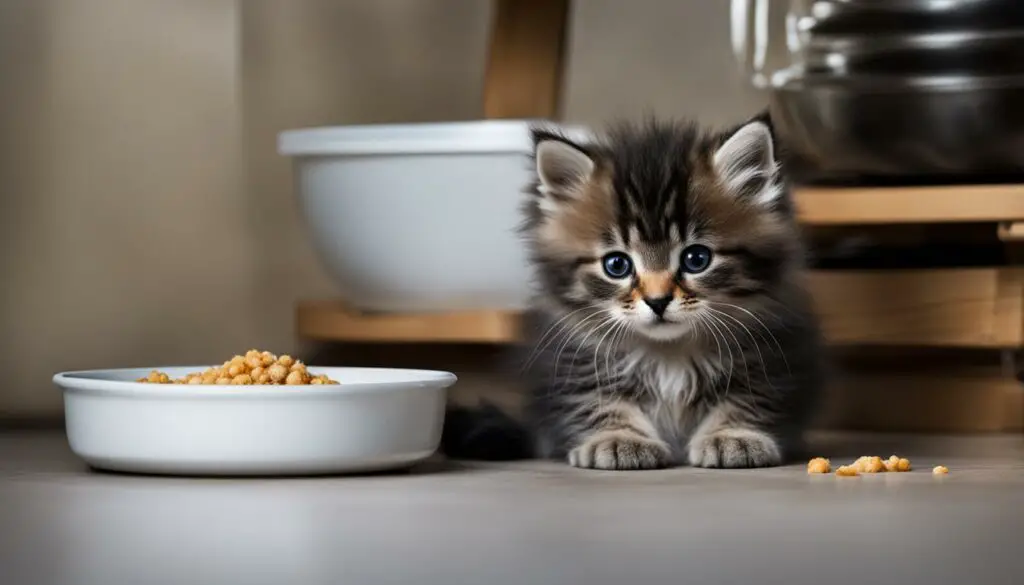
Table: Common Reasons for a New Kitten Not Eating
| Reason | Description |
|---|---|
| Stress | The transition to a new environment can cause anxiety and a loss of appetite. |
| Dental Issues | Toothaches or sore gums can make eating painful for kittens. |
| Illness | Underlying health conditions can affect a kitten’s appetite. |
Transitioning to New Food
If you’re struggling to get your new kitten to eat, it could be due to the transition to a new type of food. Cats can be quite particular about their meals, so it’s important to introduce new food gradually. Follow these tips to help your kitten adjust:
Gradual Transition:
Start by mixing a small amount of the new food with their current food. Over the course of about 7-10 days, gradually increase the ratio of new food to old. This slow transition allows your kitten to get used to the taste and texture of the new food without causing digestive upset.
Stick to a Schedule:
Establish a regular feeding routine for your kitten. Set consistent mealtimes, as cats thrive on routine. This helps them anticipate when food will be available and creates a sense of security.
Provide Variety:
Experiment with different flavors and textures of kitten food to find what your kitten prefers. Some kittens may prefer wet food, while others may prefer dry kibble. Offering a variety of options can help stimulate their appetite and make mealtime more enjoyable.

Remember, patience is key when transitioning your kitten to new food. It may take some time for them to adjust, but with a gradual approach and a little encouragement, they’ll soon be enjoying their meals.
Tips for Encouraging Eating
If your new kitten is experiencing feeding issues or having appetite problems, there are several strategies you can try to encourage them to eat. Here are some helpful tips:
Experiment with different flavors and textures of kitten food:
Just like humans, kittens have preferences when it comes to food. Try offering them a variety of flavors and textures to find out what they enjoy most. Some kittens may prefer wet food, while others may prefer dry kibble. By offering different options, you can increase the chances of your kitten finding something they like.
Warm the food to body temperature:
Kittens are more likely to eat food that is warm rather than cold. Heating up their food to body temperature can make it more enticing and appetizing. However, be sure to test the temperature before feeding to avoid burning your kitten’s mouth.
Ensure a clean and distraction-free feeding area:
Kittens are easily distracted, so it’s important to create a calm and quiet environment for their mealtime. Make sure their food bowl is clean and free from any lingering smells that may discourage eating. Place the bowl in a quiet area away from noise, children, and other pets to minimize distractions.
Remember, if your kitten continues to have feeding issues or refuses to eat for an extended period, it’s crucial to seek veterinary help. A veterinarian can assess your kitten’s health and provide guidance on how to address their specific appetite problems.
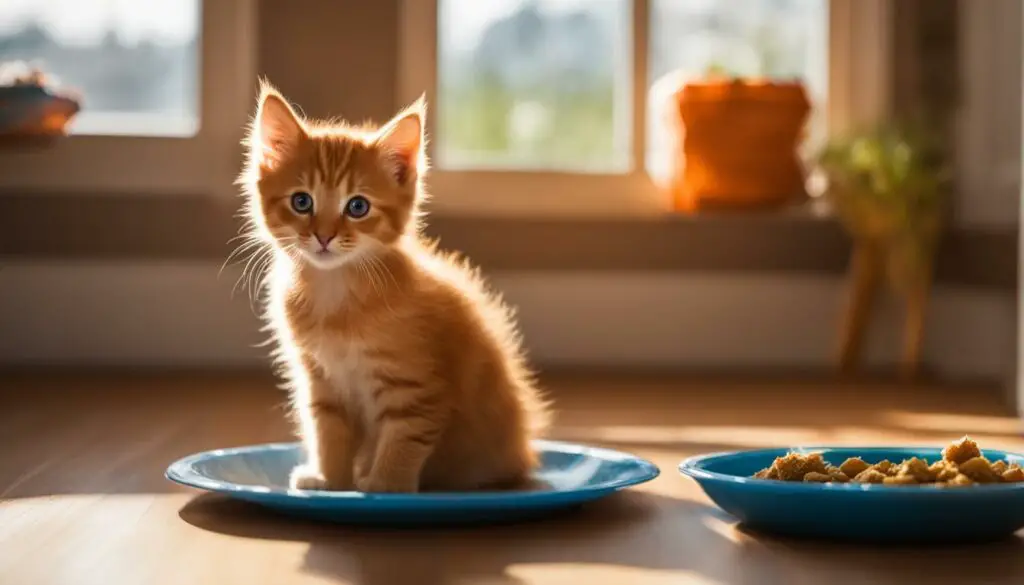
Vaccinations and Lack of Appetite
One common reason for a new kitten not eating is vaccinations. It is normal for kittens to experience a mild lack of appetite for a few days after receiving their vaccinations. However, if the lack of appetite persists for more than three days or if other symptoms develop, it is important to consult a veterinarian. Prolonged loss of appetite after vaccinations may indicate a more serious underlying issue that needs to be addressed.
Table: Common Symptoms After Vaccinations
| Symptoms | Possible Causes |
|---|---|
| Loss of appetite | Normal reaction to vaccinations |
| Lethargy | Temporary side effect |
| Mild fever | Immune system response |
During the recovery period, it is important to monitor your kitten’s overall behavior and health. If you notice any alarming symptoms or if the loss of appetite continues beyond a few days, it is best to seek veterinary assistance. A veterinarian will be able to determine if there are any complications or if additional treatment is necessary.
Remember that vaccinations are crucial for your kitten’s long-term health and well-being. Although a temporary lack of appetite may occur, the benefits of vaccinations far outweigh this short-term inconvenience. By staying proactive and seeking veterinary guidance when needed, you can ensure your kitten receives the best care possible.

Dental Issues and Appetite Problems
When it comes to kittens, dental issues can be a common cause of appetite problems. Just like humans, kittens can experience toothache and sore gums, which can make eating uncomfortable for them. If you notice that your kitten is not eating as much as usual or showing signs of discomfort while eating, it’s important to consider the possibility of dental issues.
Common dental problems in kittens include teething pain and gum inflammation. Teething pain occurs when their baby teeth are erupting, and it can make chewing and eating difficult. Gum inflammation, also known as gingivitis, can be caused by poor oral hygiene or an underlying health condition. In both cases, kittens may exhibit a reduced appetite or even refuse to eat altogether.
If you suspect that your kitten is dealing with dental issues, it’s essential to schedule a check-up with a veterinarian. A vet will be able to examine your kitten’s mouth, identify any dental problems, and provide appropriate treatment. This may include medications, dental cleaning, or tooth extraction if necessary. Addressing dental issues promptly can help alleviate your kitten’s discomfort and restore their appetite.

Section 7: Illness and Lack of Appetite
Various illnesses can lead to a lack of appetite in kittens. It’s important to be aware of potential health issues that may be causing your new kitten not to eat. Here are some common illnesses that can affect a kitten’s appetite:
- Gastrointestinal problems: Conditions such as intestinal parasites, constipation, or gastrointestinal infections can cause discomfort and loss of appetite in kittens.
- Respiratory infections: Kittens with respiratory infections may experience nasal congestion, making it difficult for them to smell their food and consequently lose interest in eating.
- Mouth or throat issues: Dental problems, oral ulcers, or sore throat can make it painful for a kitten to eat, leading to decreased appetite.
- Viral infections: Viruses like feline distemper or upper respiratory infections can cause lethargy and loss of appetite in kittens.
- Metabolic disorders: Certain metabolic disorders, such as liver or kidney disease, can affect a kitten’s appetite and overall health.
If your new kitten is not eating, it’s important to consult a veterinarian for a proper diagnosis and treatment. The vet will be able to conduct a thorough examination, run any necessary tests, and provide appropriate medical care tailored to your kitten’s needs.

Adjusting to a New Environment
Bringing a new kitten home can be an exciting and joyous occasion. However, it’s essential to remember that kittens, like humans, need time to adjust to a new environment. The transition can be stressful for them, so it’s important to provide a safe and comfortable space for them to settle in.
To help your new kitten adjust, you can start by using familiar objects or blankets from their previous home. These items will carry familiar scents and provide a sense of security. Additionally, consider using a Feliway diffuser, which releases comforting pheromones that can help create a calming atmosphere for your kitten.
Creating a designated area for your kitten is crucial. This space should include all the essential resources your kitten needs, such as food, water, litter box, and a comfortable bed. It should be in a quiet area away from noise and other pets, allowing your kitten to feel safe and undisturbed during mealtime and rest.
Table: Tips for Helping Your Kitten Adjust to a New Environment
| Tip | Description |
|---|---|
| Use familiar objects | Introduce items from their previous home to provide a sense of familiarity. |
| Consider a Feliway diffuser | Use a Feliway diffuser to create a calming atmosphere with pheromones. |
| Create a designated area | Set up a quiet space with all necessary resources for your kitten’s comfort. |
By following these tips, you can help your new kitten adjust to their new environment more easily. Patience and understanding are key, as every kitten’s adaptation process may differ. Providing a comforting environment will help them feel secure and confident, allowing them to settle in and thrive in their new home.

Creating a Feeding Routine
Establishing a consistent feeding routine is essential for the well-being of your new kitten. A regular schedule helps them develop healthy eating habits and ensures they receive the proper nutrition they need to grow. Here are some tips on how to create a feeding routine for your kitten:
1. Determine the Number of Meals
For kittens around 8 weeks old, it’s recommended to feed them three to four times a day. As they grow, you can gradually reduce the number of meals to three times a day by the time they reach 12 weeks. This regular feeding schedule helps regulate their appetite and prevents overfeeding or undereating.
2. Serve Consistent Portions
It’s important to provide your kitten with appropriate portion sizes based on their age and size. Follow the feeding guidelines on the kitten food label and adjust the portions as needed. Pay attention to your kitten’s body condition and consult your vet if you’re unsure about the correct portion size for your kitten.
3. Stick to a Feeding Time and Location
Choose a specific time and location for feeding and stick to it consistently. Kittens thrive on routine, and having a designated feeding area helps create a familiar environment for them. Make sure the feeding area is quiet and away from distractions. This helps your kitten focus on their food and promotes a calm and stress-free mealtime.
By establishing a feeding routine for your new kitten, you provide them with a sense of security and promote healthy eating habits. Remember to consult your veterinarian for personalized advice on feeding your specific kitten based on their individual needs.
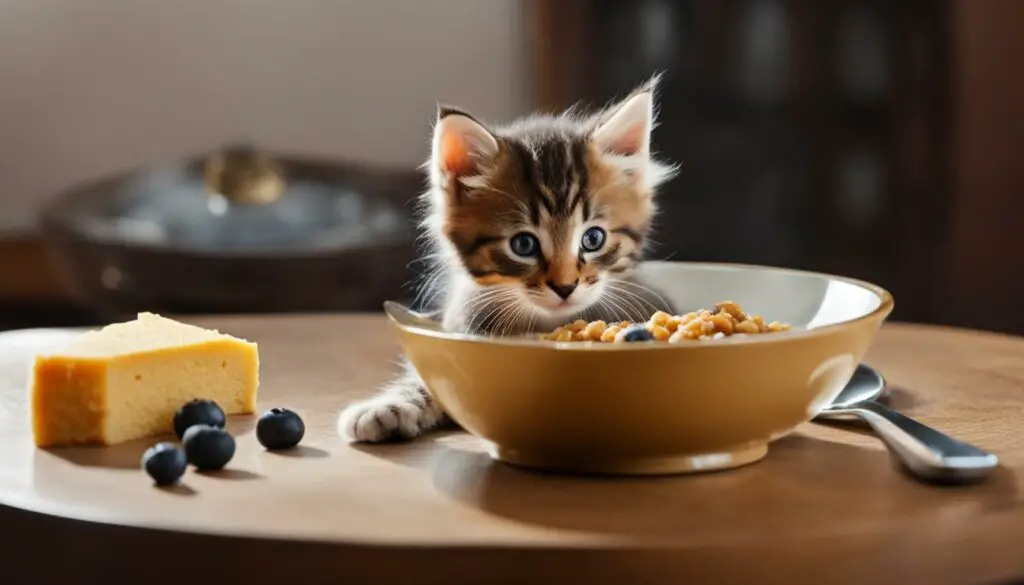
Choosing the Right Bowl
When it comes to feeding your new kitten, choosing the right bowl is essential for their comfort and well-being. One factor to consider is whisker fatigue, which occurs when a kitten’s sensitive whiskers repeatedly touch the sides of a deep bowl. This can cause discomfort and discourage eating. To prevent whisker fatigue, opt for a wider and shallower bowl that allows your kitten to access their food easily without any discomfort.

Another important aspect to consider is the material of the bowl. Ceramic or metal bowls are recommended as they are easier to clean, don’t retain odors, and are less likely to harbor bacteria compared to plastic bowls. Keeping the bowl clean is crucial for your kitten’s hygiene and overall health. Wash the bowl after each meal to remove any lingering smells that may discourage your kitten from eating.
In addition to choosing the right bowl, it’s important to create a quiet and dedicated feeding area for your kitten. This helps minimize distractions during mealtime and allows your kitten to focus on eating. Separating the food and water bowls from the litter box and placing them in a sheltered spot away from noise and other pets can greatly improve your kitten’s eating experience.
Creating a Quiet Feeding Area
Kittens can easily get distracted during mealtime, so it’s important to create a quiet feeding area for them. A peaceful environment will help your kitten focus on eating and develop healthy eating habits. Here are some tips to create a calm and distraction-free feeding area for your kitten:
Minimizing Distractions
- Separate the food and water bowls from the litter box: Place them in different areas of your home to create a clear distinction between eating and toileting.
- Choose a sheltered spot: Find an area away from high-traffic areas, noise, and other pets. This will help your kitten feel safe and reduce distractions.
Providing a Peaceful Atmosphere
- Set a regular feeding schedule: Establishing a routine will help your kitten anticipate mealtime and reduce anxiety.
- Use calming techniques: Consider using a Feliway diffuser or other calming products to create a soothing atmosphere in the feeding area.
By creating a quiet feeding area, you’ll provide your kitten with a stress-free environment where they can enjoy their meals. Remember to always monitor your kitten’s eating habits and seek veterinary help if they consistently refuse to eat.
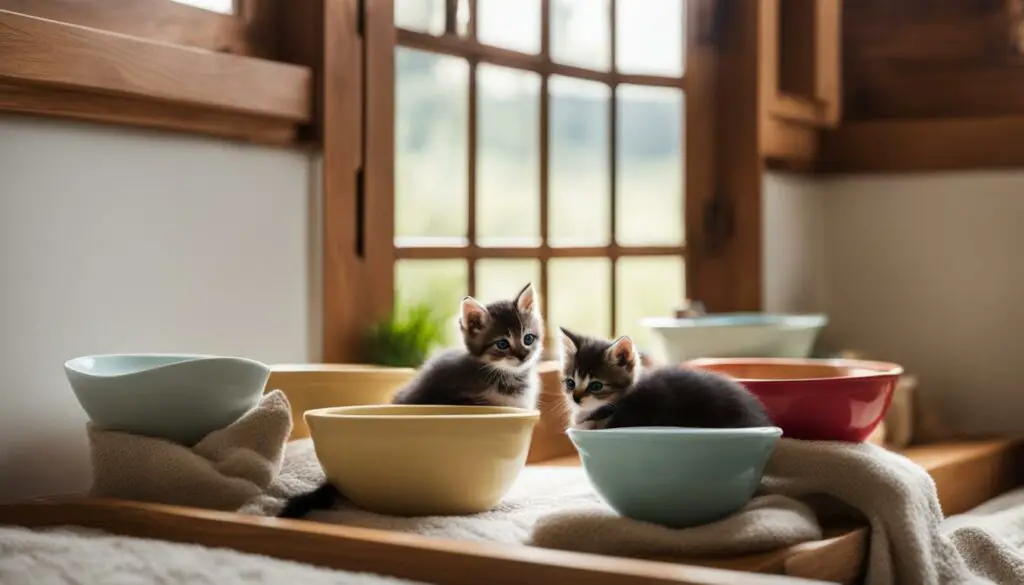
Importance of Clean Bowls
When it comes to feeding your kitten, there’s more to consider than just the food itself. The cleanliness of their feeding bowls plays a crucial role in promoting proper hygiene and ensuring they have a healthy and enjoyable mealtime experience. Dirty bowls can harbor bacteria and unpleasant odors that may discourage your kitten from eating. Therefore, it’s essential to clean their bowls after each meal to maintain a hygienic feeding environment.
Ceramic or metal bowls are recommended over plastic ones because they are less prone to retaining smells and are generally easier to clean. Plastic bowls can develop scratches and crevices over time, providing a breeding ground for bacteria. By using ceramic or metal bowls, you can reduce the risk of contamination and create a safer eating environment for your kitten.
To clean your kitten’s bowls effectively, use warm, soapy water and a non-abrasive sponge or cloth. Make sure you remove any leftover food or residue, paying extra attention to any crevices or corners. Rinse the bowls thoroughly to remove all soap residue before drying them completely. Avoid using harsh chemicals or dishwasher detergents, as these can leave behind harmful residues that might be ingested by your kitten.

By prioritizing the cleanliness of your kitten’s feeding bowls, you can prevent the growth of harmful bacteria and ensure their meals are enjoyable and free from contamination. Remember to clean their bowls after every meal, opting for ceramic or metal materials, and using gentle cleaning methods to maintain proper hygiene in their feeding routine.
Feeding Guidelines and Portion Sizes
When it comes to feeding your new kitten, it’s important to provide them with the right amount of food to support their growth and development. Following proper feeding guidelines and portion sizes will help ensure that your kitten receives the necessary nutrients without overfeeding or undereating.
The amount of food your kitten needs will depend on their age, size, and activity level. In general, kittens should be fed multiple small meals throughout the day to meet their high energy needs. The following table provides a general guideline for feeding amounts based on age:
| Age | Feeding Amount |
|---|---|
| 4-8 weeks | 1/4 to 1/3 cup per day |
| 8-12 weeks | 1/3 to 1/2 cup per day |
| 3-6 months | 1/2 to 3/4 cup per day |
| 6-12 months | 3/4 to 1 cup per day |
These are general guidelines, so it’s important to monitor your kitten’s weight and adjust the portion sizes accordingly. If your kitten consistently finishes their food quickly, it may be a sign that they need a larger serving size. On the other hand, if they consistently leave food uneaten, it may mean that you’re overfeeding them.
Remember to always provide fresh water alongside your kitten’s meals and consult with your veterinarian for personalized feeding recommendations based on your kitten’s specific needs.
Addressing Kitten Stress
Bringing a new kitten home can be an exciting time, but it can also be a source of stress for your furry friend. It’s essential to create a comforting home environment to help your kitten settle in and alleviate any anxiety they may be experiencing.
One way to provide comfort is to create a quiet and secure space for your kitten. Set up a designated area with all their essentials, such as food, water, litter box, and a comfortable bed. This space should be free from loud noises and disturbances, allowing your kitten to feel safe and relaxed.
Consider using products like Feliway, which releases calming pheromones, to promote a soothing atmosphere. These products can help reduce stress and create a sense of familiarity for your kitten. Additionally, maintaining a consistent daily routine and providing gentle attention and affection can go a long way in helping your kitten adjust to their new surroundings.
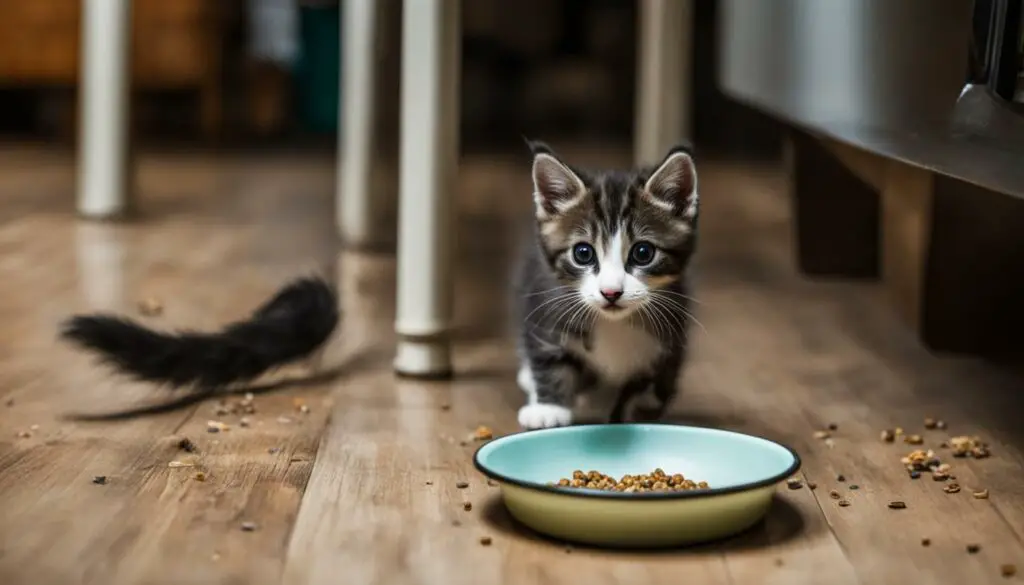
Creating a Comforting Home Environment
When addressing kitten stress, it’s important to consider various factors that can contribute to their well-being. Here are some additional tips on creating a comforting home environment:
- Provide vertical spaces, such as cat trees or shelves, for your kitten to explore and feel safe.
- Engage in interactive playtime to help relieve stress and build a bond with your kitten.
- Offer a variety of toys and scratching posts to keep your kitten mentally stimulated and prevent boredom.
- Avoid sudden changes in the environment and gradually introduce new experiences to prevent overwhelming your kitten.
By creating a comforting and supportive home environment, you can help your new kitten feel secure and reduce any stress they may be experiencing during the transition period.
| Tip | Benefits |
|---|---|
| Designate a quiet space | Provides a safe and calm area for your kitten to relax and feel secure. |
| Use calming products | Helps create a soothing atmosphere and reduces anxiety in your kitten. |
| Maintain a consistent routine | Provides a sense of stability and predictability, easing stress for your kitten. |
| Engage in interactive playtime | Promotes mental stimulation, exercise, and bonding between you and your kitten. |
When to Seek Veterinary Help
If your new kitten refuses to eat or eats very little for 24 hours or more, it’s important to consult a veterinarian. Loss of appetite can be a sign of underlying health issues that need to be addressed by a professional. The vet will be able to assess your kitten’s overall health and provide necessary treatment if needed.
When a kitten is not eating for an extended period, it can be a cause for concern. As a responsible pet owner, it’s important to closely monitor their eating habits and take action if necessary. While some kittens may experience a lack of appetite due to stress or the transition to a new environment, it’s essential to rule out any underlying medical conditions.
A veterinarian will be able to conduct a thorough examination to determine the cause of your kitten’s refusal to eat. They may perform various tests, such as blood work or imaging, to identify any potential health issues. Early intervention is key to ensuring your kitten receives appropriate treatment and can recover quickly.
Remember, each kitten is unique, and what may seem like a minor issue to one may be a significant concern for another. Trust your instincts and consult a veterinarian if you have any doubts about your kitten’s eating habits or overall well-being.

Common Signs to Look for:
- Loss of appetite for 24 hours or more
- Weight loss
- Lethargy or low energy
- Vomiting or diarrhea
- Changes in behavior
- Difficulty breathing
- Excessive drinking or urination
When to Take Immediate Action:
- If your kitten is experiencing severe symptoms such as difficulty breathing or uncontrollable vomiting
- If your kitten is very young or has pre-existing health conditions
- If your kitten’s lack of appetite is accompanied by other concerning signs
Conclusion
In conclusion, when your new kitten is not eating, it can be a cause for concern. However, it’s important to remember that this is often a normal part of the adjustment process. Stress, dental issues, illness, food transition, and environmental factors can all contribute to a lack of appetite in kittens.
To help your kitten develop healthy eating habits, it’s essential to closely monitor their eating habits and seek veterinary help if they refuse to eat for an extended period. Consulting a vet can help rule out any underlying medical causes and ensure your kitten’s overall well-being.
By following proper feeding guidelines, such as gradually transitioning to new food and establishing a regular feeding routine, you can encourage your kitten to eat. Creating a calm and comfortable environment, free from distractions, can also help alleviate stress and promote healthy eating habits.
Remember, if your new kitten does not eat or eats very little for 24 hours or more, it’s crucial to consult a veterinarian. Loss of appetite can be a sign of underlying health issues that need professional attention. With patience, proper care, and the guidance of a vet, you can help your new kitten thrive and enjoy a happy, healthy life.
FAQ
Why is my new kitten not eating?
There are several reasons why a new kitten may not be eating. Stress, dental issues, illness, or the need to get used to new food can all contribute to a lack of appetite in kittens.
How can I transition my kitten to new food?
It’s important to introduce new food gradually over a period of about 7-10 days. Start by mixing a small amount of the new food with their current food and gradually increase the ratio of new food to old.
What can I do to encourage my kitten to eat?
You can try different flavors and textures of kitten food, warm the food to body temperature, ensure a clean and quiet feeding area, and minimize distractions during mealtime.
Why is my kitten not eating after vaccinations?
It’s normal for kittens to experience a mild lack of appetite for 2-3 days after vaccinations. However, if the lack of appetite persists for longer or if other symptoms develop, it’s important to consult a vet.
Could dental issues be causing my kitten’s lack of appetite?
Yes, kittens, like babies, can experience teething pain. Sore gums can make it uncomfortable for kittens to eat, leading to a lack of appetite. It’s important to schedule a check-up with a vet to rule out any underlying dental problems.
What illnesses can cause a lack of appetite in kittens?
Various illnesses, from simple colds to more serious conditions like intestinal parasites or constipation, can cause a lack of appetite in kittens. It’s crucial to seek veterinary help if your kitten is not eating.
How can I help my new kitten adjust to their new environment?
You can provide a safe and comfortable environment, use familiar objects or blankets from their previous home, and consider using products like a Feliway diffuser to create a calming atmosphere for the kitten.
How often should I feed my kitten?
Feed kittens of around 8 weeks old three to four times a day, gradually reducing to three times a day at 12 weeks. Establishing a regular feeding schedule helps them develop a healthy eating pattern.
Should I be concerned about whisker fatigue in my kitten?
Whisker fatigue can occur when a kitten’s sensitive whiskers touch the sides of a deep bowl repeatedly, causing discomfort and discouraging eating. Using a wider, shallower bowl can prevent whisker fatigue and make eating more comfortable for your kitten.
How can I create a quiet feeding area for my kitten?
Separate the food and water bowls from the litter box and place them in a sheltered spot away from noise and other pets. This will help your kitten focus on eating without distractions.
Why is it important to keep the kitten’s bowls clean?
Kittens can be sensitive to smells in their environment, including food bowls. Clean their bowls after each meal to remove any lingering odors that may discourage eating. Ceramic or metal bowls are recommended as they retain fewer smells than plastic bowls.
How much should I feed my kitten?
It’s important to feed kittens the appropriate amount for their age and size. Follow the feeding guidelines on the kitten food label and adjust portion sizes as needed. If your kitten consistently finishes their food quickly, it may be time to increase serving sizes. If they consistently leave food uneaten, you may be overfeeding.
How can I address my kitten’s stress?
When bringing a new kitten home, provide them with a safe and comfortable environment. Use familiar objects or blankets from their previous home and consider using products like a Feliway diffuser to create a calming atmosphere.
When should I seek veterinary help for my kitten not eating?
If your new kitten refuses to eat or eats very little for 24 hours or more, it’s important to consult a veterinarian. Loss of appetite can be a sign of underlying health issues that need professional attention.
Source Links
- https://www.purina.co.uk/articles/cats/kitten/health/new-kitten-not-eating
- https://us.feliway.com/blogs/news/7-reasons-your-new-kitten-might-not-be-eating
- https://www.purina.ca/articles/kitten/feeding/new-kitten-not-eating








